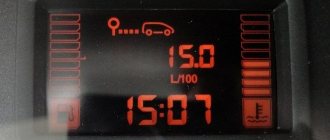Largus 5th gear ratios are excellent for those who drive the car mainly around the city, often with a full load. The shortcomings are revealed on the highway when you don’t have time to reach 100 km/h, and the engine speed is already at around 3000 rpm. You can get rid of the hum and howl of the engine and gearbox with the help of a simple modification: “replacing the fifth gear gear.”
Gear ratios of Lada Largus gearboxes
Depending on the Largus configuration, the standard 5th gear ratios may be different. Comparisons of different modifications in the table:
| Equipment | Station wagon 5 seats K7M (1.6l, 8kl), JH3 540 | Station wagon 7 seats K7M (1.6l, 8kl), JR5 551 | Station wagon 5 and 7 seats K4M (1.6l, 16cl), JR5 549 | Van JR5 517 |
| 1st gear | 3,727 | |||
| 2nd gear | 2,048 | |||
| 3rd gear | 1,393 | 1,321 | 1,393 | 1,321 |
| 4th gear | 1,029 | 0,971 | 1,097 | 0,971 |
| 5th gear | 0,820 | 0,795 | 0,892 | 0,738 |
| Reverse | 3,545 | |||
| Main couple | 4,214 | 4,5 | 4,214 | 4,928 |
Which 5th gear gear is better to choose?
The table shows the car speed values at different gear ratios of Largus 5th gear, as well as the article number of the driven and driving gears:
| Gear ratio 5th gear | Catalog number 1 | Catalog number 2 | Speed at 3000 rpm | Main couple |
| 0,892 | 8200611295 | 8200608035 | 93,6 | 4,214 |
| 87,6 | 4,5 | |||
| 80,0 | 4,928 | |||
| 0,820 | 8200611299 | 8200607980 | 101,8 | 4,214 |
| 95,3 | 4,5 | |||
| 87,0 | 4,928 | |||
| 0,795 | 8200611297 | 8200607978 | 105,0 | 4,214 |
| 98,3 | 4,5 | |||
| 89,8 | 4,928 | |||
| 0,756 | 8200611301 | 8200607981 | 110,4 | 4,214 |
| 103,4 | 4,5 | |||
| 94,4 | 4,928 | |||
| 0,738 | 8200611303 | 8200607983 | 113,1 | 4,214 |
| 105,9 | 4,5 | |||
| 96,7 | 4,928 |
Replacing Largus 5th gear gear
The design of the Largus transmission allows you to change the 5th gear gears without disassembling the entire gearbox or even removing it from the car. You will need a gear puller, a hair dryer and two screwdrivers. If you have the necessary tools, the process takes no more than 2-3 hours. Video instructions:
When replacing gears with their own hands, car enthusiasts most often encounter difficulties when dismantling a small gear. Removing it without a special puller is not so easy, because... it sits on the shaft using a thread locker. In this situation, a hair dryer can be useful; after heating, the part will easily slide off. Don't forget to fill in new transmission oil.
Preparatory work
Gearbox ratio
According to Renault regulations, when working on the Largus gearbox, the nut washer and input shaft nut, the shift fork pin and the rear end bolt of the secondary shaft must be replaced. The cost of consumables for Largus is low. This is a plus for both Russian cars and Renault cars. However, as experience shows, most services do not do this, which can lead to other damage.
To replace the 5th gear gear you will need:
- standard set of wrenches, sockets and pullers;
- punches;
- small screwdriver;
- hammer;
- rubber mallet;
- means for cleaning and degreasing the surface of parts;
- FRENETANCHE thread locker.
It is recommended to carry out all work on a special lift; if one is not available, drive the car onto a pit or overpass. Before starting work, disconnect the battery.
Reviews about 5th gear gears
Based on feedback from owners of the Lada Largus car, as well as reviews, trials and tests, we have compiled a comparison table:
| PCH-5 | Shifting to 4th gear | Hill climbs in 5th gear | Confident acceleration in 5th gear | Summary |
| 0,892 | Rarely | Confident, even with a load | from 50 km/h | Loud engine noise on the highway. Only for the city and with load. |
| 0,820 | Sometimes for fast accelerations | Confident, even with a load | from 60 km/h | The howl of the engine on the highway has become less, but you still get tired of it. When trips are more often around the city and less often on the highway. |
| 0,795 | During fast acceleration | Confident, but without a load | from 65-70 km/h | To switch to 5th gear, you have to accelerate a little longer in 4th. The hum and howl from the engine and gearbox are within normal limits. Ideal city/highway option. |
| 0,756, 0,738 | Often | You should add gas | from 75-80 km/h | The gap between 4th and 5th gear is significant. Minimum noise level from the engine and gearbox on the highway. Suitable for driving on flat terrain with occasional overtaking. |
This modification is primarily used to reduce engine speed when driving in 5th gear. Fuel savings after such upgrades are not significant. If fuel consumption with PCH-5 0.892 was 7.4 l/100km, then with 0.795 it will decrease by 0.3 l and amount to 7.1 l/100km. If you expect that replacing the 5th gear of Largus will pay off in terms of gasoline savings, then you will have to wait several years.
How do you feel about this modification of the Lada Largus gearbox? Is it worth changing the 5th gear driven and driven gears? What gear ratios are best to choose? Let us remind you that you can increase the speed of the car in other ways, for example, by installing wheels of a different diameter. And to make long trips more comfortable, you can add an armrest.
We select the optimal gear ratio for the highest gear of Largus. A set of gears will cost about 3,000 rubles, and the craftsman will charge the same amount for replacement. However, the gamble is worth the candle: a faster fifth gear will reduce engine noise and make travel more comfortable.
LADA > Largus
Features of the JH3 gearbox
JH3 gearbox parts
The JH3 gearbox on the Lada includes a clutch housing, gearbox, and rear crankcase cover. Thanks to the clutch with a bearing located in the box, the clutch in the box is turned on and off. When changing speed modes, no extraneous noise is created. The Lada Largus gearbox provides the ability to accelerate quickly. The average working life of this box is approximately 250,000 km.
The gearbox control drive includes a rocker and a lever. It should be noted that there is a bevel differential. There is a drain plug at the bottom of the crankcase. It is controlled by a rigid rod. Its body is made of aluminum alloy. The JH3 540 version can be found in the five-seater Largus, which has an 8-valve engine.
Lada Largus
Over time, you get used to the shortcomings of the car you drive all the time. But there are exceptions to the rules. For two years now I have been using the Lada-Largus editorial station wagon and still cannot accept the heart-rending roar of its engine on country roads. On a long journey, you get tired of this tedious monologue, and the rising tachometer needle puts pressure not only on the psyche: you constantly think about increased fuel consumption. Judging by the numerous unflattering comments on thematic Internet forums, I’m not the only one who doesn’t like the too short fifth gear. Moreover, this problem mainly concerns the most popular passenger version with a 16-valve 1.6-liter K4M engine. Different boxes and main pairs are installed on Largus (see table). And in a passenger car with a sixteen-valve engine, fifth gear turns out to be the most high-torque. Even the van speeds faster in fifth gear. Although logically it should be the other way around.
About the disadvantages of gears
During a thorough and repeated analysis carried out by service centers, as well as based on numerous reviews from owners, it was established that such a malfunction is typical for the LADA Largus modification, which is equipped with a popular 1.6-liter engine (“K4M”) with a 16-valve head design . It is in this version of the engine tandem with the gearbox that the same gear can cause discomfort to the owner, which is why the 5th gear gear is replaced. The manufacturer is also familiar with this shortcoming, which subsequently manifested itself in its desire to use different combinations of not only engines with gearboxes, but also different options for the main pairs in transmissions (see table).
An interesting fact is that the cargo version of the LADA Largus, the so-called “van,” in fifth gear is capable of achieving a higher maximum speed in comparison with its passenger counterpart. The manufacturer intended everything just the opposite.
The noise emitted by the 5th stage gear not only annoyingly penetrated into the cabin, but also caused increased fuel consumption due to the presence of increased friction in the corresponding gearbox unit. That is why many owners of the model replace the fifth gear.
WHAT IS GOOD?
The standard sixteen-valve box has both pros and cons. Among the advantages is the ability to provide dynamic acceleration and excellent elasticity. A car with a gross weight of nearly two tons and armed with only a 105-horsepower engine confidently stays in traffic, and in fifth gear it cheerfully picks up from 50 km/h - there is no need to shift often. On long hauls, sometimes you drive for several hours in fifth as if on automatic. It’s convenient, but you have to pay for it with increased noise and fuel consumption - and even when the speedometer needle has not even reached a hundred. Therefore, together with the specialists from our technical center, we decided to experiment with different gear ratios. After all, the design of the Largus transmission allows you to change fifth gear gears without disassembling the entire box or even removing the unit from the car. By the way, owners of Renault models (for example, Logan or Sandero), as well as Nissan-Almera, can similarly configure the top gear for themselves.
There are different sets of gears on sale, each of which will cost about 3,000 rubles. The craftsman will charge the same amount for a replacement. The beauty is that you won’t have to part with the car for a long time: a competent repairman can handle it in a couple of hours. Let's try!
03–05
Fuel consumption on the Lada-Largus test route with different fifth gears.
Gear ratio: 0.892 (1); 0.820 (2); 0.795 (3). Fuel consumption on the Lada-Largus test route with different fifth gears. Gear ratio: 0.892 (1); 0.820 (2); 0.795 (3).
There are different sets of gears on sale, each of which will cost about 3,000 rubles. The craftsman will charge the same amount for a replacement. The beauty is that you won’t have to part with the car for a long time: a competent repairman can handle it in a couple of hours. Let's try!
THREE FROM THE CASTER
Editorial "Largus" tried on three pairs of gears with different gear ratios. In addition to the standard fifth gear of 0.892, we sequentially installed sets of 0.820 and 0.795 (see table). On a 300-kilometer test route, including highways and suburban roads, they compared the difference in fuel consumption and accumulated subjective assessments, which are sometimes even more interesting for the car owner than measurement data. For reliability, the expert assessment was supported by measurements at the Dmitrovsky test site. Test results and comments are presented below, including photographs, tables and diagrams.
0,892. The basic version provides excellent elasticity. Fifth gear can be used from 50 km/h even when fully loaded. You rarely have to shift down - the traction reserve is enough even for quick overtaking. But the noise of the engine operating at high speeds is annoying, even if you are moving no faster than the permitted 90 km/h: on long trips you quickly get tired.
Summary. The basic version is good for those who move mainly around the city, often with a full load
0,820. The engine is no longer perceived as so elastic, but still within normal limits. You only have to shift to fourth gear for quick accelerations. Even with a full load and in fifth gear, the car easily overcomes climbs, and on horizontal sections it confidently picks up speed from 60 km/h. At the same time, it became significantly quieter at high speeds. The gain on fuel is insignificant.
Summary . A universal option for every day. Fifth gear is quite functional in the city, and driving on the highway has become more comfortable. We recommend that AVTOVAZ take this option as the base one.
0.795. My personal choice . Editorial "Largus" is rarely fully loaded, and on country routes I usually drive on roads with flat terrain. The number of shifts from fifth to fourth on the test route increased, but only slightly. When upshifting, I stayed in fourth gear a little longer before engaging fifth, and when overtaking, on the contrary, I began to shift from fifth to fourth more often.
Summary. Optimal for suburban highways, tolerable for trips around the city. If you load your car to capacity or drive on roads with long, steep climbs or frequent overtaking, choose the 0.82 option.
0.756 and 0.738 . We have not tested these options, but judging by our impressions of the 0.795 fifth gear box, they accumulate the shortcomings of the previous option. Elasticity will deteriorate, you will have to shift from fifth to fourth more often, and there will be a significant gap between these gears.
Summary . These options are convenient, for example, for driving on a flat and empty highway at a constant speed and rarely overtaking.
Possible breakdowns of Largus manual transmission
LADA Largus is a family vehicle equipped with a transmission system that is well suited to work in difficult road conditions and when traveling over rough terrain.
With prolonged use of the Lada Largus, its owner may encounter problems such as unclear gear shifts.
Vehicles need diagnostics if there are problems with engaging reverse gear. In some cases, this is a consequence of the fact that the working properties of the filled oil have deteriorated. The transmission fluid must be replaced if it has changed color. The howling of the box may be the reason that there is insufficient oil in the gearbox. Gears must be subjected to mandatory inspection.
Diagnostics of the box is relevant if an increased stroke of the handle is observed. It should be noted that when undergoing diagnostics on a Lada, the condition of the spark plugs and filters is checked. When these consumables break down, the car starts to accelerate worse and fuel consumption increases.
If the Lada is frequently used in aggressive conditions, the functioning of the gearbox may deteriorate prematurely. In particular, extraneous noise and squeaks will appear as a result of bearing wear. These components must have a good level of lubrication.
Thus, Largus can be equipped with manual gearboxes JH3 and JR5 (5 steps), which include synchronizers for all forward gears. They differ in clutch release units. Malfunctions can occur due to many reasons, ranging from gear wear to spontaneous loosening of bolts. The use of non-original auto parts during repairs helps to reduce the service life of the gearbox.
Overhaul of a gearbox always begins with vehicle diagnostics. Thanks to computer diagnostics, it is possible to accurately determine the nature of the malfunction present. If it is necessary to repair these gearboxes, you should contact a specialized service.
"LADA-LARGUS": CHANGING THE FIFTH GEAR GEARS
We hang the car on a lift or on stands and remove the left front wheel.
1. Dismantle the plastic mudguard, carefully freeing it from the pistons and latches.
2. Unscrew the upper bolt of the subframe bracket, loosen the lower one and move the bracket to the side so that it does not interfere.
3. Unscrew the fastening of the power steering pipeline to the gearbox and remove the connector from the reverse switch.
4. Unscrew the drain plug, drain the oil and screw the plug back. Unscrew the three bolts of the rear transmission cover.
5. and carefully remove it so as not to damage the lubricant groove. Use a rod to knock out the pin that secures the fifth gear fork.
6. Move the fork towards you and engage first gear with the lever: the primary and secondary shafts are blocked - this makes it easier to unscrew the gears. Unscrew the input shaft nut.
7. Remove the synchronizer fork and clutch, the driven gear and the fifth gear synchronizer hub. It is more convenient to use a two-jaw puller with thin legs.
8. Having unscrewed the bolt of the secondary shaft, remove the drive gear.
9. Change the gears and assemble in reverse order. A few notes about the assembly. We recommend applying a few drops of a fixative (for example, Frenetanche) to the splines of the drive gear. We tighten the nut of the primary shaft to a torque of 190 Nm, and the bolt on the secondary shaft to 80 Nm. Don't forget to fill the box with oil, preferably fresh.
And most importantly. We changed the gears ourselves, fortunately we were not opening the first box and we also have the appropriate tool. If you don't have enough experience or courage to replace it yourself, leave the job to professionals.
Brakes
Brake pads, Drum pads, Pad wear sensor, Pad repair kit, Pad spacer, Rear pads, Handbrake pads, Front pads, Brake linings, Brake discs, Rear brake discs, Front brake discs, Brake drum, Rear brake drum, Drum bearing, Brake hoses, Brake pipes, Brake caliper, Caliper repair kit, Rear caliper, Caliper guides, Front caliper, Caliper piston, Caliper boot, Caliper bracket, Hydraulic accumulator, Vacuum brake booster, ABS, ABS unit, ABS sensor, Vacuum pump, Brake pedal, Switch Brake Light, Air Brakes, Parking Brake, Handbrake Cable, Brake Cylinder, Master Cylinder, Brake Reservoir, Brake Service Cylinder, Rear Brake Cylinder, Front Brake Cylinder, Brake Cylinder Repair Kit
What will be needed for replacement?
First of all, you will have to buy a set of 5th gear gears for replacement. At Logan-Shop.SPb such kits are available in two versions - with a gear ratio (u) of 0.756 or 0.738.
If you do everything yourself, then you will need a set of sockets (from 10 mm to 27 mm), a wheel wrench for removing the wheel, a hammer and a lot of small things (which are found in any garage).
It is advisable to have a lift - this will greatly simplify the process.
It would also be very useful to have special pullers for gears. However, such a tool, as a rule, cannot be found on open sale, and not every car service center has it. At Largus-Service this type of work is carried out using just such pullers. Of course, a simple puller with two or three legs, which can be bought at any auto parts store, is also suitable. But if you lack experience, you can accidentally damage gearbox parts.
In this article we will look at the process without the use of special tools.
Checking the level and topping up
Before changing or adding lubricant, you should check the oil level in the box. This is not as difficult to do as many may think. If you have minimal experience and skills, you can easily cope with the task with your own hands. In the case of a Lada Largus car, for work you will need to take:
- a syringe that will be used to add the missing liquid;
- rags;
- an empty container for several liters;
- key square for 8;
- oil similar to what is in the box.
Special syringes are used, available in auto parts stores. Do not confuse them with medical syringes, which are not suitable for such purposes. Special topping and filling tools have a hose that allows easy access to the filler neck. When everything is ready, you can begin to assess the amount of oil in the box and add the missing amount of lubricating fluid to the Largus gearbox.
The work is carried out according to the following algorithm of actions:
Remove the engine protection. People often call it the central mudguard. The essence does not change from the name. Find the filler plug, which can often be easily unscrewed with a square wrench. Before opening the cap, place an empty prepared container under it to avoid spilled puddles of oil. According to the standards, the level should be located slightly below the filler hole. If it is less, then you will need to add the missing amount of gear lubricant. A syringe pre-filled with oil is inserted into the filler neck. Gradually pour in the viscous liquid. At some point, lubricant will begin to flow through the hole.
Wait until it stops running completely, then wipe everything with a rag and screw the plug back into place. During the process of checking and topping up, pay attention to the condition of the rubber O-ring on the plug. If the machine is used for a long time and actively, the ring may wear out. It is better to replace it immediately, since a worn seal will break the seal and the oil will gradually leak out
Such a ring costs about 5 - 10 rubles, so serious expenses for such repairs will not be required.
It is better to replace it immediately, since a worn seal will break the seal and the oil will gradually leak out. Such a ring costs about 5 - 10 rubles, so serious expenses for such repairs will not be required.
If you did everything correctly, the oil is not leaking anywhere and the gearbox is functioning normally, then the transmission fluid level is sufficient and you can continue to operate your car.
How to change fifth gear gears?
Let's start by removing the oil pan protection. Unscrew the bolts 10 mm, being careful not to twist them. And this is quite possible: they often sour well, so if you don’t want to bother with drilling them later or attaching the protection with self-tapping screws, you need to unscrew them carefully. However, regular WD40 can help.
Drain the oil from the gearbox. Everything here is elementary, unless you confuse the engine crankcase and gearbox.
We unscrew the filler plug and tighten the drain (not forgetting to install a new sealing washer).
All that remains is to install the protection, and at the same time treat the protection bolts with any grease to prevent them from souring in the future.
Let's move on to the front left wheel. How to remove a wheel is unnecessary to explain.
We find the “lamb” on the fender liner at the top left of the wheel. We turn it counterclockwise and move the fender liner, fixing it directly on the bumper. Before us is a view of the gearbox, partially blocked by the subframe amplifier. It will also have to be removed by unscrewing two bolts.
We find the reverse sensor connector: it is screwed into the gearbox, there are simply no other sensors there. Remove the connector, then disconnect the wiring from the gearbox cover. It is usually attached with a plastic clamp that can be easily removed with wire cutters.
After making sure that nothing prevents you from removing the gearbox cover, unscrew its bolts. We wipe our hands and remove the lid to the side.
In front of us are the gears of the 5th gear, which we have to replace. The hardest thing is to remove these stars. It will be much easier to install new ones.
First we have to pull out the 5th gear shift fork. Therefore, we take a drift, a hammer and try to knock out the pin that secures it to the shaft. He will have to be beaten from the bottom up, which in itself is already interesting. Instead of a drift, an ordinary drill will do just fine: it’s not a shame to break it, and choosing the right diameter is not difficult. So, we begin to knock on the pin and watch how it slowly creeps up. There is no need to hit with a hammer with all your might; the box, although powerful, is quite fragile in places.
After the pin has flown out of the plug, we begin to remove it. She needs to be pulled towards herself. If you decide to do without special pullers, then, provided that you have an assistant, this is done as follows: one holds the fork with his hand, the second quietly taps the shaft through a drift. If you are careful but persistent, everything will work out and the fork will be in your hands.
Now we remove the gears, starting with the input shaft.
We unscrew the nut, then carefully pick up the washer behind it and pull it out of the seat. It happens that they fly away somewhere into the bowels of the garage after the pin, but if in addition to the sprockets you purchased a new nut, washer and pin, there is no need to crawl on your knees with a flashlight.
Next we try to remove the first gear from the input shaft. Here a special puller is used. But in its absence we act differently. You can try to carefully pry it off on both sides with ties and pull, but most likely this will not be effective. Then we take a regular universal puller and use it.
Largus gearbox oil: partial and complete replacement
Let's start with the fact that the manufacturer indicates in the manual that there is no need to change the oil in the Lada Largus gearbox, that is, the gearbox is considered maintenance-free. In other words, it is filled with lubricant for the entire service life of the vehicle, and changing the transmission oil may only be necessary if the gearbox is repaired.
In practice, the situation is somewhat different, since any lubricants have their own service life. In parallel with this, gearbox wear products accumulate in the oil. This means that the oil in a fully functional gearbox needs to be changed earlier to protect the unit from wear.
Taking into account the recommendations of specialists and experienced car enthusiasts, it is optimal to replace every 60-80 thousand km. If the car is constantly used in difficult conditions, then changing the oil in the gearbox may be necessary after 50 thousand km. mileage
So, on the Lada Largus, Elf 75W80 Tranself TRJ oil is poured into the gearbox from the factory. As for the level and condition of the transmission oil, it is optimal to perform checks every 15-20 thousand km. In this case, in the case of topping up, you need to use only the oil that is already poured into the gearbox.
This means that even if a lubricant with similar properties was selected, an undesirable reaction may occur between the additive packages, which will lead to a significant deterioration or loss of useful properties of the entire volume of lubricant.
If a complete replacement is performed, the old lubricant must first be drained, after which transmission oil is poured in, which meets all manufacturer’s tolerances.
Let's move on to checking the oil level in the Lada Largus gearbox and adding lubricant to the gearbox if necessary. To check the level and add oil to the box, you need to prepare: a syringe, a container, a wrench with a square head of 8, suitable oil.
The necessary syringe can be purchased at an auto parts store. At the same time, the kit includes a rubber hose that allows you to reach the filler holes.
- To check the level, first you need to remove the engine protection, after which you need to unscrew the gearbox filler plug with a key. In this case, before unscrewing the plug, you should place a container so that the oil does not spill on the floor.
- Normally, the oil level in the gearbox should be slightly below the edge of the filler hole. If there is not enough oil, it needs to be added. To do this, you need to insert a syringe filled with lubricant into the filler neck.
- The liquid is added until it begins to flow out through the control hole. In this case, you need to wait until the oil stops leaking. Only after this can you tighten the plug, after wiping the place where it is installed with a clean rag.
- Let's also add that there is an O-ring on the plug. If its condition or integrity is in doubt, then it is better to replace such a ring immediately. Otherwise, oil may leak from under the plug.
If there is a need to completely change the oil in the Largus gearbox, the procedure will require similar tools and actions as with regular topping up. In terms of filling volume, about 3 liters of gear oil will be required.
It is also advisable to keep a small reserve, since there is a possibility that during further operation it may be necessary to add oil to the box.
Please note that the box can fit less than 3L. oil, since certain residues of old lubricant remain in the cavities of the box
You should also pour fresh oil into the filler hole slowly and gradually.
Once lubricant begins to flow out of the inspection hole, we can assume that the box is completely filled with transmission fluid. In this case, you need to tighten the plug, after which it is advisable to start the internal combustion engine and at idle speed with the clutch depressed, you should engage different gears of the manual transmission.
This will allow the oil to be distributed throughout the gearbox. In some cases, after this procedure, the engine is turned off, after which the lubricant level in the gearbox is checked again.
What happened?
In this case, gears with u=0.738 were installed.
At a speed of 120 km/h, before installing new gears, the experimental Largus consistently maintained 4,000 rpm. Now the crankshaft only makes 3,200 revolutions. The difference is very significant.
Gear sets come with different gear ratios, and if you don’t know which one is best to choose, it makes sense to consult a specialist.
By the way, you don’t have to suffer in the garage yourself. At Largus-Service, the cost of replacing fifth gear gears is 2,500 rubles.
We wish success to those who dared to carry out this work on their own and do not forget that the oil must be changed after 1000 km!
Let us note that this type of work is primarily beneficial to the owners of a Lada Largus with a Renault 1.6 16V engine and allows them to make movement more comfortable.











